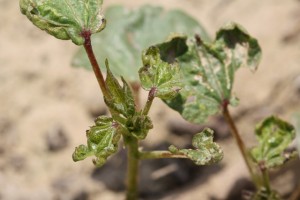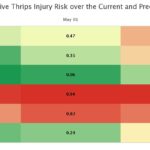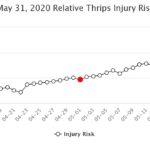A reminder the Thrips Infestation Predictor for Cotton described in the article below, published last year, is still available for use. However, the link has changed to https://products.climate.ncsu.edu/ag/cottontip/.
———————————————————————-
The Thrips Infestation Predictor for Cotton is a useful tool for predicting whether a foliar insecticide application is needed for thrips control in cotton. It uses local weather data in association with a user defined planting date to estimate the size of the local thrips population, the susceptibility of seedling plants, and thus, the risk of thrips injury. The model is for tobacco thrips, by far the most common species infesting cotton in Tennessee.
You can run the model fo r planting dates up to two weeks beyond the current date. I do not suggest using this model to making planting decisions, as we all know that is driven by weather and opportunity. You should chose the most optimal planting dates based on agronomic considerations. However, the model is very useful for predicting the need to spray for thrips in addition to using an insecticide seed treatment.
r planting dates up to two weeks beyond the current date. I do not suggest using this model to making planting decisions, as we all know that is driven by weather and opportunity. You should chose the most optimal planting dates based on agronomic considerations. However, the model is very useful for predicting the need to spray for thrips in addition to using an insecticide seed treatment.
The website is simple to use. You select a planting date and ‘drop a pin’ of your location on the map. The model will predict the risk of thrips injury for that location and planting date plus or minus other possible planting dates in that same time frame. The graphical outputs are easy to interpret and explanations of the output are also included (examples below). For example, at this time, it appears that cotton planted in West Tennessee before May 7th is at relatively low risk to thrips injury, and the risk of thrips injury starts to increase beginning about May 10th. HOWEVER, the accuracy of these predictions will improve if you re-run the model closer to or even after the actual planting date.
Give it a try! I think you will like it, and it can help you prioritize the need for making a foliar insecticide application to control thrips.




